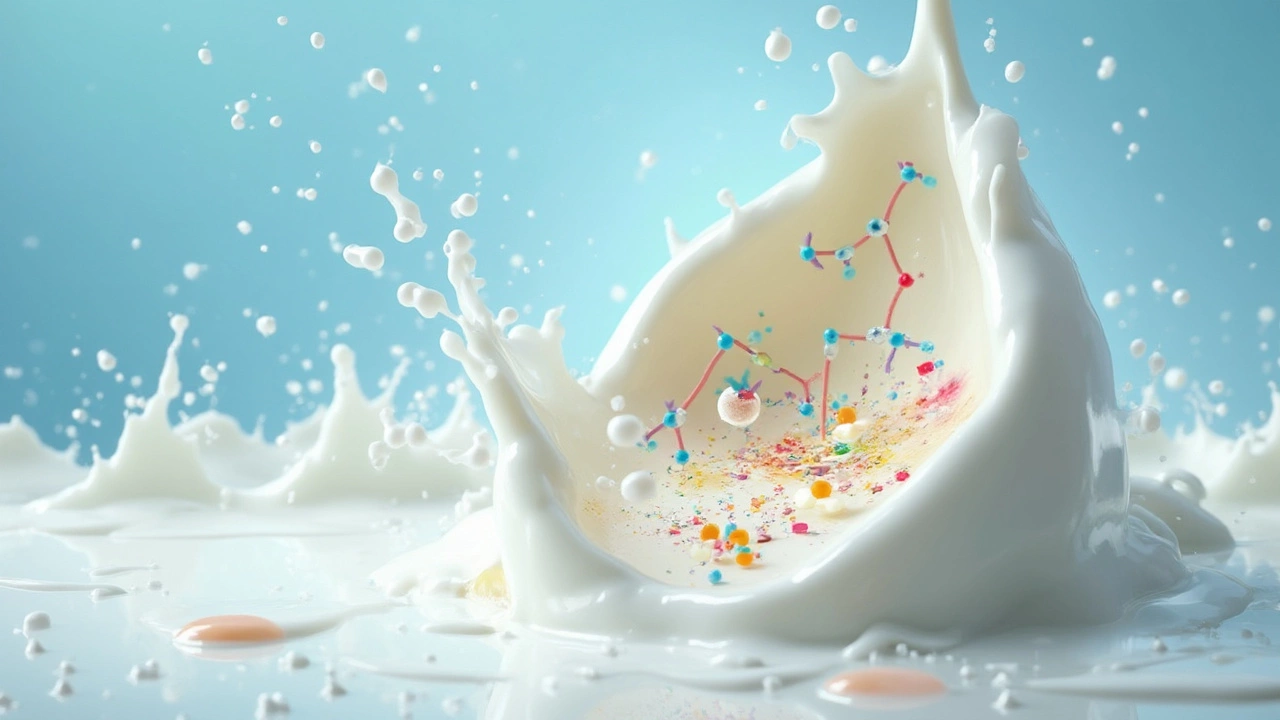Ever stood in your kitchen, staring at a pot of stubborn milk that refuses to transform into paneer no matter how much acidity you add? It's frustrating, right? You're definitely not alone. Making paneer is practically a rite of passage in Indian kitchens, but it can throw a curveball or two.
Let's get down to milk basics first. Fresh, full-fat milk is your best friend here. Skim milk or anything that’s been sitting in the fridge for days may not curdle as well. It's also worth mentioning that ultra-pasteurized milk is a no-go for paneer—it’s been heated to such high temperatures that the proteins don’t curdle as they should.
Now, how's your acidic agent game? Lemon juice or vinegar usually does the trick, but you need the right amount. Too little and your milk stays annoyingly soupy; too much and it can get bitter. It's all about balance and timing.
Understanding the Basics
Before diving into where things might be going wrong, let's talk about how homemade paneer magically comes together. At its core, it's all about the chemistry between milk and an acidic agent—like lemon juice or vinegar—that causes milk to curdle, forming those delightful cheese curds.
The Role of Milk
Using the right milk is half the battle won. The best results come from fresh, full-fat milk. Full-fat milk has the right amount of fat and proteins, which are key players in forming those soft curds. Ever wondered why skim milk doesn’t cut it? Simply put, it just lacks the fats necessary for a good curdling action.
Curdling Agents at a Glance
The obvious choices for curdling are lemon juice and vinegar. Both work well, but keep an eye on the quantity. If you go overboard, it might give an unwanted sour tang to your paneer. Ideally, you should add the acid slowly, stirring after each addition. This approach lets you see when the milk separates without risking over-acidification. Here’s a quick tip: some folks even use yogurt to gently coax their milk into curdling.
Heat and Patience
Heat is another essential element. You don't want the milk boiling furiously—just a gentle simmer. Think of it as warming the milk enough to dissolve sugar for your coffee. Once it’s at the right temperature, that's when you introduce your acid, and this is where your patience will be your best friend. Stir slowly, let the magic happen.
Understanding these basics gives you a better picture of how to achieve that perfect homemade paneer. Next time you aren’t getting those lovely curds, review these elements. Sometimes a small adjustment can transform your paneer-making experience!
Common Mistakes
Alright, so you're ready to make some homemade paneer, but things aren't going as planned. Let's break down some of the usual slip-ups that lead to your milk not curdling right. If you're nodding along to any of these, don't worry—easy fixes are usually right around the corner.
Using the Wrong Type of Milk
First things first, your milk choice is crucial. If you're using ultra-pasteurized milk, no wonder it's not working. The high heat processing alters the proteins in a way that prevents proper curdling. Always go for fresh, full-fat milk. Think of that delicious richness it brings!
Temperature Troubles
Temperature can be a trickster. Milk needs to be just right—about 85-90°C (185-194°F). Too hot or too cold, and the game is over before it begins. A kitchen thermometer can be your best friend here.
Acidic Agent Awry
Getting the hang of your acidic agent—be it lemon juice or vinegar—is key. Add it gradually and stir continuously. If it's dumped in all at once or if you skimp on it, you may end up with scalded milk instead of the curdling action you're hoping for.
“A little patience goes a long way when it comes to homemade paneer. Allow the acid to do its job over a gentle heat, and you'll be rewarded with perfect curds.” — Chef Sanjeev Kapoor
Improper Stirring
Another common blunder is stirring too aggressively. Gentle stirring prevents breaking up the forming curds, ensuring they last until it’s time to strain them.
Environmental Factors
Weirdly enough, humidity and altitude can also mess with your paneer-making game. High altitudes can affect boiling points and, consequently, the curdling process. Don't worry, though; this usually just means a bit of trial and error to get your timing and temperature spot-on.
Not Letting It Sit
Last but not least, remember to let things sit once your milk turns into curds. Letting it be untouched for about 10 minutes helps the proteins set correctly. Rushing this part could leave you with a sad, crumbly version of the paneer you dreamed about.

Tips for Success
Getting paneer to come out perfectly doesn't need to feel like rocket science. A few handy tips can make all the difference, so let’s jump right into it.
Choose the Right Milk
Opt for fresh, full-fat milk. Avoid ultra-pasteurized variants as they inhibit proper curdling. Full-fat milk means creamier paneer, which tastes better.
Measure Your Acid Correctly
The balance of acidity is crucial. Use about two tablespoons of lemon juice or vinegar per liter of milk. Too little won’t trigger curdling, while too much may alter the taste negatively.
Maintain the Right Temperature
Keep the milk at a gentle simmer before adding the acid. Boiling is too hot, lukewarm is too cool. It should be steaming and just about to bubble.
Stir Gently
When adding the acid, stir slowly and see how the milk reacts. This gentle touch ensures larger curds, leading to a smoother final product.
Patience is Key
Once curdled, let the mixture sit for about 10 minutes. It gives the curds time to properly form and set before you strain them.
Draining Techniques
Use a clean muslin cloth to drain. Gather up the corners and hang it above the sink, allowing the whey to drain naturally. The longer you hang it, the firmer the paneer becomes. A good 30 minutes should be your sweet spot for most dishes.
Save the Whey
Hold on to that whey! It’s not just a byproduct. Use it in soups, dough, or even pasta water for a nutritional boost.
Follow these steps, and you’ll be on your way to homemade paneer perfection. It's all about making subtle tweaks until you find what works best for your kitchen vibe.
Alternative Methods
If your attempt at making paneer has got you pulling your hair out, fear not! There are a bunch of alternative methods you can try that still give you the creamy block of goodness you crave.
Yogurt as the Magic Agent
Yogurt is an awesome alternative to the classic lemon juice or vinegar. It adds a slight tang, which many find tasty. Here’s a simple way to use yogurt:
- For every liter of milk, add about half a cup of yogurt.
- Heat the mixture gently, keeping a watchful eye out for the curdling to start.
- Once you see separation, remove from heat and let it rest before straining.
Chef Amrita Gill mentions,
"Yogurt-curdled paneer has a pleasant taste and often produces a softer texture than traditional methods."
Using Buttermilk for a Twist
Not just a drink, buttermilk can also be the star in your paneer-making journey. It's all about the slight acidity and enzymes:
- Heat about a liter of full-fat milk in a pot.
- Pour a cup of buttermilk and stir gently.
- Allow it to separate and remove from heat once you see the curds form.
Buttermilk often results in a beautifully smooth texture and mild flavor, a win-win if you ask me!
Using Tofu as a Cheat
Now, this is a bit unconventional, but if you're in a pinch, tofu can stand in for paneer in many recipes. Just season it well, and you'll get a surprisingly similar vibe with minimum hassle.
To switch up your homemade paneer routine, experiment with these methods and see which one tickles your taste buds. While the curdling science may sound intimidating at first, with some patience and practice, you'll figure out what works best in your kitchen and maybe even start enjoying the process!

Troubleshooting
Sometimes, despite our best efforts, things just don't go as planned. If your paneer isn't cooperating, don't stress. Let's tackle some common curdling issues and how to fix them.
Milk Isn't Curdling
First off, check the quality and type of milk. Are you using full-fat milk? That's key. Skim milk can skimp on the curdling action, so make sure you're not cutting corners there. Also, avoid ultra-pasteurized milk since the proteins have been treated too heavily.
Milk Temperature
The milk temperature needs to hit that sweet spot. Make sure your milk is just about boiling but not scorched. If it’s not hot enough, even the best acidic agents won't do the trick.
Acidic Agents Not Working
If the milk still won't curdle, double-check your acidic agent. Freshly squeezed lemon juice or plain white vinegar usually works. Introduce it gradually and stir gently. You might have to adjust the quantity based on your milk's freshness—older milk can need more kick.
Curds Are Too Soft or Hard
If your curds are either mushy or rock-solid, it might be a case of too little or too much acid. Fine-tune the amount of acid you add and the timing of when you add it. Adding it too early or too late can mess with the texture.
Didn't Drain Properly
Proper draining is crucial. If excess whey sticks around, your paneer will be soggy. Paste cheesecloth over a sieve, and ensure gravity does its job. If it's too dry, you probably let it drain too long or squeezed it with too much force.
Make a Small Batch First
Sometimes, step back and make a smaller batch to test the variables. Experiment with milk types, acid amounts, and heating levels to find the balance.
Quick Troubleshooting Checklist
- Use fresh, full-fat milk.
- Avoid ultra-pasteurized or previously boiled milk.
- Ensure milk is hot enough.
- Measure acidic agents accurately.
- Drain whey thoroughly but gently.
